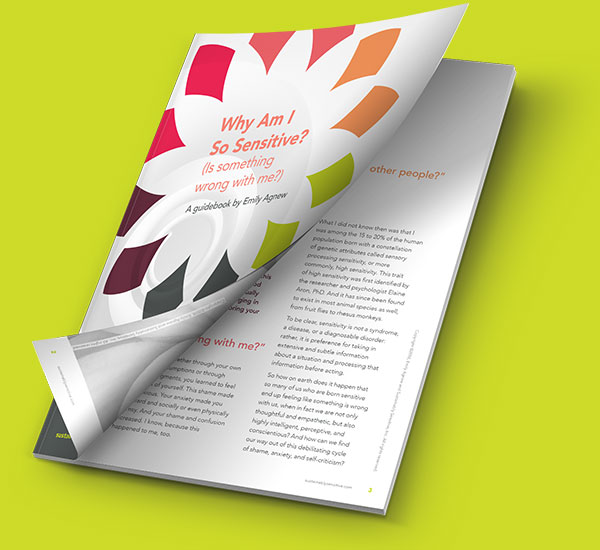Is it truly possible to enjoy your overwhelm? Yes, if you learn how to be with it in the right way.
If you are highly sensitive, you feel things deeply. Strong emotions come with your temperament. You can’t stop yourself from having the emotional reactions you have. You might as well try to send rain back up into the sky.
You can, however, put on a raincoat. In emotional terms, this means choosing how you respond to your strong emotions. Many HSPs begin to fear their own emotions, having felt overwhelmed by them. But this fear, unlike the original feelings, is negotiable. You can shift from fearing your intense emotions to actually enjoying them. You start by learning how to be present with your feelings.
In the world of Inner Relationship Focusing—the branch of Focusing developed by Ann Weiser Cornell and Barbara McGavin, this state of mind is called Self-in-Presence. I’ll refer to it as Presence, for short.
For HSPs, Presence is a godsend. We can learn to expand into Presence in the moment. The more you do this, the more you’ll begin—hard as it may be to imagine—to enjoy your intense emotions, and to appreciate them as messengers carrying important information. Let’s explore the qualities of Presence so you can recognize it and cultivate it in yourself.
What exactly is Presence?
This beautiful photograph, taken by my friend Kaitlyn Wyenberg, shows why a picture is worth a thousand words. Presence is a lived experience. But this photo, along with the metaphors I’ll share below, can offer you a sense of this way of being.
Presence is spacious
When you are in Presence, you feel as if there is room in you for anything and everything that is here, now. Don’t be hard on yourself, though, If the “room for anything” you are able to muster feels more like a broom closet than a vast blue sky. When I’m really “up against it,” I count myself lucky if my sense of Presence is a single molecule thick. But that’s enough: any air is better than none. I think of it as a tiny oxygen suit that keeps me from drowning in sadness or anger.
Presence has a quality of stillness
In Presence, I am aware of being here in this moment. This can manifest as subtle quality of inner quiet, even when you are in action. Think of the space shuttle. It orbits outside Earth’s atmosphere, moving silently through space, without apparent hurry. Yet in reality, it is moving 17,500 miles an hour. Presence is like this. It is still, even in the midst of physical or emotional activity.
Presence feels accepting
The space shuttle moves in its calm, unhurried way even if the astronauts inside are anxious. The key is to hold awareness of both experiences. I am the shuttle…and I can sense something in me feels anxious. Both are true, and I can be the space where both can exist. I don’t have to agree with everything that I’m sensing in me, though, in order to accept it. That is, I don’t have to “like” the anxiety in order to keep my “molecule suit” of awareness around it. From Presence, I can simply hold “what is.”
Presence feels like fresh air and flowing water
When I’m present with my inner world, I feel refreshed, relieved, and renewed—the very opposite of stuck, hopeless, confused, or overwhelmed. Quite a paradox. Many HSPs have learned to escape into our minds in an attempt to avoid our intense feelings. Unfortunately, this is like putting a stopper in the spout of a boiling kettle. The kettle doesn’t stop boiling: the pressure just builds up. Stepping back and opening up just that little bit to embrace your whole experience is like taking the stopper out.
Presence feels open to possibility
From Presence, you can see a long way. Your horizon is expanded. This expansion energizes you and makes you curious: “I wonder what is behind that island over there…I wonder how far the water stretches, before it reaches the open sea…” Curiosity and wonder are footholds out of anxiety and depression. If you feel curious, you haven’t succumbed to hopelessness or powerlessness.
Presence brings perspective
You could even say that Presence IS perspective. From Presence, you recover your sense of the right relation to things, people, and events in your life. But if Presence were only perspective, it would be the same as meditative awareness: that is, a consciousness that witnesses but does not interact with what it is witnessing. Presence is more than that.
Certainly, the witnessing qualities of Presence—the curiosity, the spaciousness and openness to possibility, the stillness, the sense of fresh air, and the attitude of acceptance I’ve described—are wonderful in themselves. But by themselves, they are not Presence. Presence is relational. That is, you come into Presence in relationship to something. For HSPs, your intense feelings are that “something.”
Presence and the inner relationship
Your inner parts, which hold your complex feelings, need a relationship with you, in order to be fully expressed. With the act of cultivating a state of Presence, you create exactly that kind of inner relationship with your feelings.
Once you’ve come into Presence with something that is going on in you, how can you take the next step to deepen your relationship with that “something”? One way is to use a mindful kind of language that Ann and Barbara call Presence Language. Start by describing what you are experiencing. Then use the words you’ve come up with to fill in the blanks of this sentence:
I’m sensing [something in me] that feels_________.
Example: I’m sensing something in my stomach that feels tense.
Example: I’m sensing something in my heart that feels like a heavy ball.
As you say the words back to yourself, sense if they resonate with the place you’re describing. If they do, then wait. Sense what comes next, then describe that. If the words aren’t quite right, sense what words might work better to describe this experience you are having, then sense if those fit.
What if the feelings in you simply feel bigger than you? Try a simple body scan. Let your awareness flow through your body. (I like to start with my feet and move up towards my head.) Do you sense any places that feel good right now? Often, even if I’m really upset or stressed, I’ll realize upon scanning that my feet and legs feel fine, along with my hands and arms.
That’s a lot of bodily real estate. However, even if only my left hand feels good, that’s enough. That’s all I need to create a “molecule suit” of Presence. By staying aware of this good feeling, I get just a bit “bigger”—big enough to hold and turn towards the upset places in me.
Presence is a paradigm shift
You don’t have to wait until the floodwaters rise to try this. Just notice what is going on in you now. Humans are biased to notice pain first, so be sure you also notice any place in yourself where you feel spacious, still, or at ease. Even the fact you remembered to do this indicates a level of Presence.
Then, notice how everything feels different. From this place in yourself, you no longer fear your emotions. You can truly appreciate them as messengers bringing insight. With Presence, you can actually enjoy your overwhelm. You can more deeply savor your good feelings.
A final note
Our toughest personal issues are, by definition, the issues around which we most struggle to come into Presence. I do a lot of inner processing on my own, but I seek skilled support around my toughest stuff. Why? Because going in there alone can feel like being thrown off a cliff in a paraglider. I might be open to trying paragliding (even though heights scare me.) But I’d have to do several tandem flights with an instructor before I’d even consider it. Deep inner work is like that.
As a practitioner, I offer clients this “tandem experience” so you can go places you couldn’t go by yourself. Over time your range and independence will increase, which is exciting. If you need this kind of support, you can reach me here.
In the meantime, though, give your HSP self a gift: cultivate of Presence as a daily practice. Keep paying attention and creating the space within you for whatever is going on in you to be as it is. Your Presence muscles will get stronger and stronger.
Image: ©2025 Kaitlyn Wyenberg (kaity.wyenberg@gmail.com). Thank you, Kaitlyn.
Note: This is a substantially edited version of the post that first appeared here on Oct 5, 2015.




















Love it!!!
Kim, thank you! Is there any particular way this was helpful to you?
Yes, Emily. I like the way the headings, “Presence is…” provide a road map for the qualities of Presence. As I skim down the headings, and since I have some previous experience with Presence, I have a strong inner sense of agreement and recognition when I read them: “Ah yes, that’s what Presence is like.” It’s a good feeling 🙂
This looks more like Buddhist meditation practice.In fact all meditation varieties stress on being present.
Dear Bhasker, you are quite right that in this article I stressed the aspects of Presence that reflectthe mindfulness of Buddhist practice, which is part of my background. What I did not talk about so much here is that in the context of Focusing, Presence is a more interactive kind of active state. Rather than just observing and allow things to pass by, you come into a relationship with them. You interact with them from a place of deep it acceptance.
Thanks,Emily , for pointing out the difference between Buddhist meditation and Presence, viz, developing relationship with the THINGS that we observe.
Opening paras of the article helped me understand the difficulties my son (now aged 37 yrs) is experiencing. He is diagnized schizophrenic(!).your opening para ” sensitive introverts get overwhelmed a lot” is aptly fitting his situation. This gives me the clue why he gets mad (!) facing many day to day situations, even ones which may give lot of happiness to a normal person.
It was a pleasant surprise to get idea of the remedy- prescription / line of treatment to recover.In fact I have already started the experiment on him with good results and am hopeful of getting him normal in days to come.
I wish parents of schizophrenics and their “therapists” see this article and go deeper in to this way of approach.
Thank,Emily your blog has confirmed my line of treatment for my son.
Bhasker, I am hearing how much you want to understand and support your son. I am not trained or qualified to work with schizophrenics but am glad if what I have written has offered you support in some way. I wish you the best with your son.
Emily, nice to know you took interest in my situation.As I go deeper into understanding what must be going on in the mind of my son(who docs say is sizophrenic!), I realize more and more that lot of people are having difficulties in adjusting to the social interactions due to anxiety and other such related emotions. Developing presence in the true sense, especially through yogic meditation ( like Kriya yoga ) helps not only understand my mind but those of people around me ( friends,family & staff members etc). This in turn helps me in dealing with them in a peaceful and joyful way.
Yes Bhasker, I agree, meditation is key…